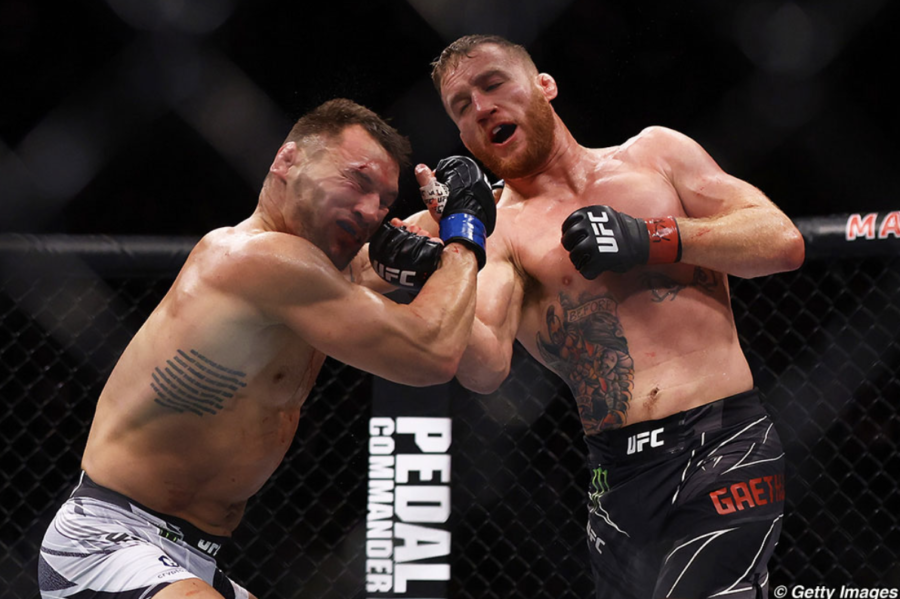MMA in American high schools
UFC fighter, Justin Gaejthe uppercuts other UFC fighter, Mike Chandler.
Mixed-Martial-Arts (MMA) have recently been on the rise. Names such as Conor McGregor, Chuck Liddel, Georges St. Pierre, and Khabib Nurmagomedov are all household names for their achievements in the UFC.
MMA is a global sport, with fighters who come from all over the world to participate in sanctioned professional fights under the Ultimate Fighting Championship (UFC), or other MMA leagues: Bellator, Cage Warriors, and many more.
Under the leadership of UFC President Dana White, the organization has been able to grow MMA, pushing it into mainstream sports media.
So, where does the sport go from here?
The next step that MMA will take is the Olympics where sports, such as boxing, judo, karate, taekwondo, wrestling, and fencing already compete in the Olympics.
After MMA joins the Olympics, what would be the next step for MMA?
If MMA continues to gain traction, the next step would be to include MMA within high school and/or college athletics.
The decision to include MMA in the high school scene would definitely be a controversial one. Many people would be quick to make the obvious argument of, MMA being “too dangerous” or the fighting being “too brutal.”
Large quantities of MMA viewers aren’t ardent viewers of the sport though. The majority of fans watch the big-name fights, like Conor McGregor or Tony Ferguson. So, most people who watch the “big” fights, end up translating what they see there to all MMA fights.
But watching any amateur fight, the audience will realize rather quickly that it’s not all lights and thunder.
The UFC is the Hollywood of MMA, with high-octane fights, heavy in action, and full of excitement. The UFC’s goal is to entertain their fans with high-quality match-ups, which they’ve been able to achieve with some of their fights making up to 2.4 million dollar pay-per-view buyouts.
Along with this, MMA isn’t as dangerous as it’s made out to be by the media. As it turns out, training happens to actually be quite safe. MMA fighters wear protection during training, which includes, shin guards, headgear, elbow pads, and on some occasions, fighters even wear a belly pad.
A belly pad is used to protect the stomach when fighters plan on throwing kicks to the stomach, most often used in Muay Thai training.
When MMA becomes dangerous is when the cannons fire.
Fight night is the most anticipated night of each fighter’s life. Where the real punches and kicks fly.
According to Naval Crime Investigation (NCIS), 23.7 of 100 fight participants suffered an injury of some sort during their fight. The most common injuries are skin lacerations, fractured bones, and concussions.
However, when comparing these numbers to high school football injuries, the statistics don’t look so off-putting.
As reported by PubMed, 12 people die annually due to high school football. The injury numbers are also unsurprisingly high with at least 300,000 injuries per year. With about 14 out of 15 injuries ending up in the emergency room.
An obvious counterpoint is that more people play high school football than compete in sanctioned MMA fights.
This is true; however, the numbers still don’t add up in comparison to MMA. Comparatively, seven people have been recorded dead from participating in an MMA competition.
Thus, if high school football isn’t too dangerous for minors, then why would MMA be too dangerous for them, considering they both report similar statistics.
However, similarly to football, concussions are a significant problem.
The biggest concern for fighter health is the long-term effects, especially Chronic Traumatic Encephalopathy (CTE).
It’s currently impossible to detect CTE while alive, therefore, the number of fighters with CTE is currently unknown, however, most suffer their first symptoms (depression, anxiety, aggression, and impulsivity) in their mid 20’s/30’s. They later experience more symptoms around their 60s.
For the most part, this can be avoided with a new rulebook for high school athletes, focused on promoting fighter safety. Headgear could be worn to protect the head, as well as using gloves with more padding to lessen the impact of the blow from a punch.
Personally, I see no reason why MMA shouldn’t become a high school sport.
It offers an excellent workout that would be helpful in fighting childhood obesity, a major problem in America’s population, specifically, adolescents.
MMA teaches self-defense, builds confidence, creates a strong mental temperament, and anyone can participate, regardless of their size.
Assuming MMA were to be accepted as an appropriate sport for high school athletics, how would it operate?
I believe it would most likely work as the wrestling program does. Fighters would train together, however, they would have separate individual matches.
Fights would be set up with another school’s team, where the fighters would compete against one another, and whichever team wins the most matches, wins the competition.
MMA should be added to high school because it offers a surplus of benefits and isn’t as dangerous as it’s made out to be.
Your donation will support the student journalists of Highlands High School. Your contribution will allow us to cover our annual website hosting costs.



